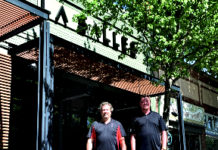
Jason Garte runs one of radio’s most successful imaging companies. But back when he first dipped his toe in the radio business, he had no idea what imaging was. Garte started his radio career as a mixer at WPOW/(Power 96) in Miami back in 1996, when he was just 14 years old. The station was running promos for a mix-off, inviting DJs to a local competition. Garte beat 35 others to advance to the semifinals on South Beach, where he won again. Then it was off to the finals, which were broadcast live on Power 96. Garte would win the entire competition and as a result get a spot mixing on the radio once a week.
Garte worked his way up to board op, then got on the air as a jock. He says that while hanging around the station, he dabbled in the production room, learning production and how to work all the equipment. Then, in 2000, he was named the very first imaging director for Power 96. They paid him $10 an hour, and it wasn’t very long, he says, “before I smacked right into the proverbial glass ceiling while living paycheck-to-paycheck.”
On January 10, 2003, Garte called his cousin, a lawyer, and she helped him incorporate the Mix Group. “I remember thinking to my 21-year-old self, ‘I’m young enough that if this doesn’t work out I can always become a lawyer, a dentist — something.’ But word traveled fast, and Garte quickly booked a handful of stations and got himself to the point that he was financially stable enough to take the risk of quitting his job at WPOW. “At the time of my departure in September of 2004, I had about 11 stations, give or take,” he says. “I was on my own, and figuring out how to become a businessman. I knew my trade well, but running a business, even as small as we were back then, was certainly challenging, having only known radio and having no formal background in business management.”
That lack of business background led to one unlucky business relationship that almost ended Garte’s company. However, his heart and desire to be a success overcame the obstacles along the way, and today a relationship with Premiere Networks is making him a very successful entrepreneur. Here’s the story of how Jason Garte and the Mix Group overcame the odds.
RI: What is a mixer at a radio station?
Garte: The mixer is also referred to as a DJ, or “turntablist,” who blends music in sync and on beat during what is referred to as a mix show. This is not to be confused with the jock on the air, announcing. Mix shows are most commonly found on contemporary CHR, rhythmic, urban, and similar formats. Nowadays, there are even some country mix shows, but that’s pretty much the scope of formats where that applies. When I got my start at the age of 14, they’d usually schedule me at 10 p.m. on a Sunday night. It was a horrible time slot, but for me it was great fun, as all of my middle school friends would rave about my performance the next day at school.
RI: Most people who are in the radio business starting out would say, “OK, I have to go to a different market. I have to pay my dues.” You decided to start your own business.
Garte: Very good point, and I actually point that out a lot, that I was not nomadic in my career, as many people can say about theirs. It was actually a blessing, I feel. When I started Mix Group, the initial concept was to supplement my income, because I literally couldn’t even make ends meet just working at Power. I’m telling you, I was still very young and I recall my mom trying to cram 20s in my hand and saying, “Your cupboards are bare. Go buy some food.”
So I was just trying to get by and used imaging, which I ended up being really good at, as a tool solely to make ends meet and pay bills. It wasn’t that I was so entrepreneurial, honestly. I really didn’t know the first thing about selling it. I didn’t know the first thing about sales. I didn’t know the first thing about marketing — I didn’t know the first thing about anything. All I really knew how to do was the actual imaging. From that, I just built everything else. The business part, of running, creating, and growing the business, I learned all of that along the way. What led me to resist exploring options in other markets, at other stations, was the fact that I had a couple of clients that were already on and I just said, “Well, that’s working,” and the word of mouth was traveling. It just kind of happened.
RI: Who were some of the first clients you had?
Garte: KZFM in Corpus Christi, Texas, was my first radio station I landed while still working at Power. Amazing story there, actually: Last week we just booked them again! Great to have them back on. Then, from KZFM, I booked KDHT in Austin. From there, to KHTY, a Clear Channel urban in San Antonio. Right after that I got my first big one, WPWX-FM in Chicago, for Jay Alan. We still produce them to this day. Their loyalty is a great blessing, and I truly love those guys. That was my fourth station. Once you pick up Chicago and you start promoting that, people start to pay a bit more attention to you.
About a year later, I signed with Premiere Networks on December 10, 2005. I think when we signed with Premiere, we had grown to about 35 stations or so. Ten years later, we are closing in on 1,000 stations. We’ve really grown this thing into a monster and are the largest provider of custom imaging production, proudly maintaining and constantly developing our staff of 18 full-time producers, and never subcontracting.
We have also done tremendously well with a concept that I pioneered back in 2007 with the signing of CESD voice talent Pat Garrett, on WZHT in Montgomery, Alabama. So much, in fact, that in 2009, I formed an entirely separate but complementary entity, Mix Talent Management, to market and offer first-rate voice talent to stations on barter. This paved the way to a really strong model of stations being able to get their imaging production and voiceover done completely on barter, without having to spend a single dime.
RI: Tell us about how your relationship with Premiere came to be.
Garte: At the beginning of 2005, I was hearing from some of my stations that they had production libraries or similar services that were being furnished to them from networks like Premiere. Some of these stations were saying to me, “You guys should totally get into that.”
At the same exact time, believe it or not, I was contacted by a fly-by-night company who signed us to offer our services on barter. At the request of that company, we ended up converting all of our stations to barter, which was about 30 to 35 stations. They would bill advertisers for us, and collect on our behalf. However, they literally kept every single dollar. We never saw a single penny. As you can imagine, things got dangerously tight because we did convert every dollar of cash-paying stations and had effectively sacrificed our entire revenue stream.
Obviously, this was for the better, they were telling us. “Stations that are currently giving you $500, you will make upwards of $750 or more if you convert them to barter.” In theory, it seemed like a fantastic deal, with the only real exception being the teensy-weensy fact that we never actually got paid. This lasted throughout the entire year of 2005. Finally, at the end of 2005, when all of our stations had already been converted to barter and they weren’t really able or even interested in reverting to paying cash, it seemed like our business was going to implode.
In a sheer panic and effort to save the company (and my livelihood), I literally called every viable radio network. Most would tell me, “You’ve only got 30 something stations. There’s not enough meat on the bones there to make any money.” Finally, in a last-ditch effort, I called the seemingly most impossible of all options, the largest of them all — Premiere. Believe it or not, they were the only network that was willing to take us on, and asked me to come on out and have a meeting in Los Angeles.
Mike Capozzoli brought me to Eileen Thorgusen, who in turn brought me to then Premiere CFO Dan Yukelson. They saw something in Mix and sent me back home to Miami with a contract in hand. I was able to move those barter stations — thank God — over to Premiere and finally monetize them in a 15-month effort to get back on our feet. As you can imagine, 2006 was a rocky year, recovering from 2005, where that other network really screwed us.
RI: Did you ever get anything out of
them in court?
Garte: No, sir. We were just seconds from suing, with an airtight case. Premiere basically said, “We want to sign you, but if you are about to get involved in a bunch of drawnout litigation with this other network, you’ll have to do that alone, and we’ll have to pass. However, if you’re interested in releasing them, then we can get going.” What a tough decision at the time. I was broke. My company’s future was hanging by a thread, but I made the risky decision to let go of now to pursue a bigger, brighter future. I had to let them off the hook in order to proceed with bigger business, which I would do again 10 times over because of what it has clearly allowed us to do in the long run.
RI: And you are still with Premiere today.
Garte: Yes. We’ve been working together for the last 10 years and just signed a long-term renewal.
RI: Tell us about some of the services Mix Group offers.
Garte: We are laser-focused on imaging. One of our taglines is “We are radio imaging.” In other words, Mix is just about radio imaging. Period. We don’t wander outside of our core competencies. We don’t do jingles. We don’t do libraries. We are entrusted with the absolutely vital, final product that goes into the automation system, directly out of the stick, and on the air. When we work, we will utilize libraries, jingles, and other desired components to create a powerfully produced product, but we’re that final person working with the programmers and voice talent to get it all done and orchestrate the entire thing. We do our 100 percent custom production on cash and on barter.
We’re solving a major problem here. If you really think about it, imaging is the number one-heard thing on a station, after music and jocks. Most commonly, there is a budget for on-air staff, and oftentimes none for imaging. Imaging is your prime branding and audioidentification element on the radio station. Even in a PPM world, it’s vital.
You need to consistently drive your brand, your energy, and your station’s overall attitude into your listener’s heads if you want them to identify with you and keep coming back to feed the meter.
RI: You started out with about 30 stations. How were you able to grow it to the almost 1,000 you have today?
Garte: It was very organic. We’ve tried, as any business has, to add fuel to the fire. Sure, you want to just go out there and you want to sell. We’ve worked with a bunch of different sales reps from time to time and tried to do typical affiliate sales. Over here, we just help people get what they want from us. We don’t muscle them and push them around.
I have always made it my mantra that I would never sell myself to anyone. I simply want to educate the broadcast world on what we do here and what makes us truly different from any of the alternatives. Plus, we do a really killer job for all of our current stations. I think a lot of industry services are focused on those huge call letters from major markets. We’ve always been different, doing a great job for anyone who would put their faith in us, no matter the market or station size.
Take for example, Colby “Colb” Tyner at Radio One. He was the program director and operations director at WENZ in Cleveland, and we’d always done a really killer job for him. He’s at the top of his game, and as a result he became the vice president of programming for Radio One. When he got into that position, Mix
Group imaging, his secret tool that he used at the station level, is something that he is now using at the corporate level, and doing a bunch of stations with us.
Imaging is also commonly referred to as branding. If we are not good at branding ourselves as a company, how can we possibly have the capacity to brand a station? Our strong presence in the trades and our creative involvement in industry events and conferences is yet another great thing that I think we do quite well.
RI: Along the way, when you were being scammed that one year and you only had 30 stations and you had no food in the cupboard, you could easily have thrown in the towel. What kept you going?
Garte: I have an unwavering drive and obsessive work ethic that propels me directly through any challenge and toward the next success. I make a comfortable living with the company, but if you look at the amount of stations we have and the company revenue overall, and then you look at my personal life, there really is not as strong a relation between the two as one would think. Every time the company scores, or we have excess cash left over after the bills are paid, I double down yet again and invest it right back into the company.
You have to push through the dark times, as we did, for example, in 2005 and again in 2007, when we tried to dual-purpose our facility to include a recording studio in efforts to pick up a little NTR. All of the major Miami recording artists, from Pitbull and Jason Derulo to Gloria Estefan and a few movie stars, worked in our studio. But we never made any money — in fact, I lost a couple million on the entire project. It was a bad move, and we ultimately sold it. Got to cut your losses.
Now we run a leaner and cleaner operation in a beautiful space in downtown Miami. These were hard lessons along the way. I can tell you that it has never, ever been a smooth road and comfy ride. It has always been a razor-sharp close call, where we almost lost it all, literally, every single time.
RI: What advice do you have for managers about being successful?
Garte: We are all in a corporate world nowadays. I think it’s tough to find your own personal identity and really be bold and do the things that you may want to do within that sort of space. But I think everybody needs to find a way to do something big and do something authentically strong, even within their limitations.
I also understand managers are discouraged because they’re not financially compensated the way they feel they should be, so they don’t invest as much time or passion into their work. Regardless, my thinking is quite the opposite. I think what you need to do is something major, something big that attracts attention to you. I am giving the advice that I follow myself. No matter what the situation is, or what hindrances lie ahead, you still have to find a way to really create a strong brand today. That’s the problem. People are talking about competition from streaming and other forms of media, etc. In order to keep radio thriving and keep this thing going big and strong, we all need to do unique and creative things that really attract attention, especially all of the guys on the front lines — the content creators.









